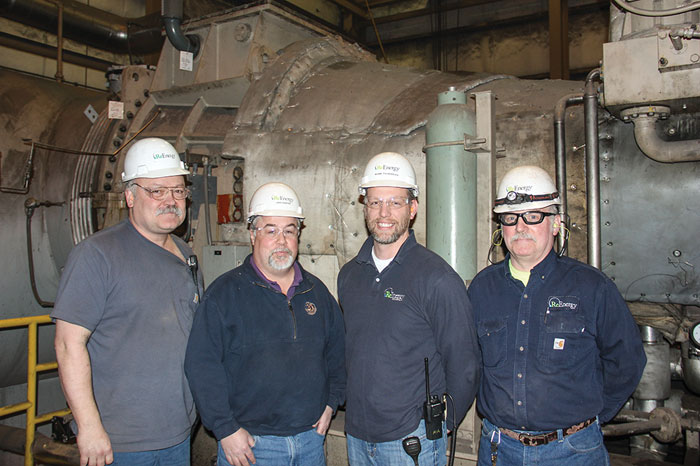ReEnergy Holdings, based in Latham, NY, acquired the idled Ashland, Me. biomass power plant in December 2011 as part of a multi-power-plant purchase from Boralex, and began working on a plan to restart the facility. Since northern Maine is on its own operating system, and is not tied to the rest of New England, but instead is tied to New Brunswick, Can., market conditions were challenging for a restart. The grid reliability over the years, thanks to different market factors, became very unstable, so the ReEnergy facility in nearby Fort Fairfield, Me. was running on high critical status quite often and was often told not to come off line or drop any megawatts. Something supplemental was needed.
The Ashland restart became possible due to a number of factors, including energy market changes, availability of transmission capacity and a growing need for a local outlet for mill and forest residues. The restart project began in late July 2014, under wraps, and the facility was brought to commercial operation on October 22, 2014. The four key players on the Ashland restart and management team will say that even though a lot of blood, sweat and tears were poured into the facility during that time, the end result was worth it.
“Collectively, with the group we had here, we did a helluva job. We spent a lot of nights here and a lot of weekends here. Most of our wives were asking us if we had girlfriends up in Aroostook County, because we weren’t coming home,” John Sawyer, ReEnergy Senior Engineer and restart Project Manager says with a big laugh. During WoodBioenergy’s visit to the facility, the excitement and energy amongst the restart and management team was palpable.

The ReEnergy Ashland restart management team, from left, Mark Bossie, John Sawyer, Mark Thibodeau and Paul Brabant
Coming On-Line
During the restart, the four-man team split time between Fort Fairfield and Ashland. Sawyer is based in Maine, but travels between the facilities; Paul Brabant was the maintenance manager at Fort Fairfield, moonlighted at Ashland during the restart, and is now located full time in Ashland as the Maintenance Manager. Mark Thibodeau is ReEnergy’s Regional Manager for the Fort Fairfield, Ashland and Stratton plants. He serves as ReEnergy Ashland’s Facility Manager. Mark Bossie, like Brabant, worked full time at Fort Fairfield, while moonlighting at Ashland during the restart. Now, he is located full time in Ashland as Operations Manager.
Before any work could be done on the existing facility, the team had to reenergize the existing substation, which took a lot of work behind the scenes, a lot of electrical testing in order to get conveyors running. Sawyer says the first big project was to restore the backfeed from the substation back to the facility.
A lot of TBDs popped up on the ever-growing list of projects to complete. After a while Sawyer just started writing TBM, To Be Mark, or TBJ, To Be John. “We drew a lot from our internal resources. Stratton’s I&C tech and mechanics came up to help with certain things, as well as Fort Fairfield and Livermore Falls. By doing it ourselves, a lot of people gained a lot more experience, and the quality of work was a lot better,” he believes.
Sawyer says on the original schedule in Microsoft Project there were 400 to 500 rows of things to “check on” or “find out about” or “consider.” After he added his items, he sent it around to the team, who put their thoughts in it. It was hard work, he says, but it was definitely fun.
The best part in his mind? There was only one phone line and limited internet. “We didn’t get inundated with things that weren’t valuable to the start up. We could kinda do our own thing.
“We all agreed on a schedule. We had probably 40 things under the wood yard. Then we split it up. I had a section, Paul had a section, Scott (another engineer) had a section and we all became project managers in those areas. So if it didn’t work you were going to have to answer some questions,” Sawyer explains.
It was a fast restart for the company, much faster than corporate anticipated. According to Sawyer, December 1 was the projected date for producing reliable power. ReEnergy Ashland was producing reliable power on October 22.
“I think our corporate people were a little surprised about what we did within the time we did it in,” Sawyer says. “Once this really started rolling and got the momentum up, people were saying, ‘Holy moly we gotta make sure we get the wood in there because John and Mark are going to be ready to light this thing,’” he adds laughing.
Within coming on-line, in a 24-hour span, the plant was at 36 MW. Full capacity is a gross output of 39 MW, which is capable of producing approximately 284,000 MWh of electricity each year—enough to supply nearly 37,000 homes.
Thibodeau believes that the work done in Ashland could act as a guide for future ReEnergy startups or restarts. “We made some mistakes and we were wrong sometimes, but we had a lot of lessons learned and overall it was a huge success. It’s a building block for the company. We did it with 100% internal resources from the company—we did the startup without hiring one single outside consultant,” he says with pride.
For ReEnergy as a company, safety is the top priority. Bossie recounts that during the restart there were no recordable injuries.